Bluespotted Stingray
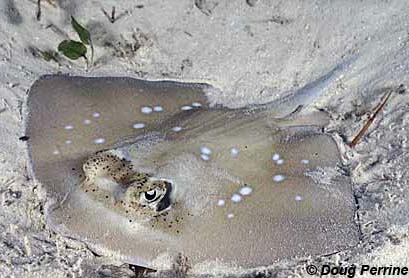
Dasyatis kuhlii
The slightly diamond shaped disc of this stingray tends to be red-brown to green-yellow on top, with bright blue spots and small black spots, and a darker brown bar across its eye region. It is often confused with the bluespotted ribbontail ray, but the bluespotted stingray has a more angular disc and a narrow tail that is twice the length of its body, with black and white rings at the end. This stingray is not aggressive, but it has two venomous spines in its tail and spends some time mostly buried in sand, and likely will react when stepped on or threatened.
Order – Myliobatiformes
Family – Dasyatidae
Genus – Dasyatis
Species – kuhlii
Common Names
English language common names for Dasyatis kuhlii include bluespotted stingray, blue-spotted stingray, blue-spotted maskray, blue-spotted stingaree, blue-spotted stingray, and Kuhl’s stingray. Other common names are bloukol-pylstert (Afrikaans), cá duôi bông (Vietnamese), chittipi-tan (Sindhi), dahunan (Tagalog/Bikol), daragon (Bikol), fai-malie (Samoan), fai-tala (Samoan), faiyemeet (Carolinian), grijze pijlstaartrog (Dutch), kalbog (kuyunon), krabane jamoog-woa (Thai), Kuhls pigrokke (Danish), kunnoo-tirike (Tamil), kuyampao (Bikol), leik-kyauh sun-maung-shin (Burmese), lukhmah (Arabic), nek pa (Kumak), page (Davawenyo/ Kuyunon/ Pangasinan), pagi (Bikol/ Hiligaynon/Ilokano/Tagalog), pague (Surigaonon), pakat (Marathi), palwa (Marathi), pari lalat (Malay), pari macan (Malay), pari riman (Malay), pari rimau (Malay), pari tanjung (Malay), pasa-pasa (Banton), pulli-thirukhai (Tamil), raie à points bleus (French), requin raie (French), shemen-tenkee (Telugu), uge ponteado (Portuguese), vali (Gela), yakko ei (Japanese), and yakko-ei (Japanese).
Importance to Humans
The bluespotted stingray is very common and commercially important in parts of the Indo-West Pacific region. It is caught in bottom trawls, trammels, and fish traps. The meat is sometimes utilized but this species is of limited value due to its small size.
Danger to Humans
Members of the Dasyatidae family generally do not attack in an aggressive manner. When rays feel threatened, their reaction is to swim away however, when they are stepped on or attacked by predators, the barbed spine on the tail is whipped up causing injury to the aggressor. Humans typically get “stung” by this spine by stepping on a stingray that is partially buried in the sand or sediments.
Conservation
> Check the status of the bluespotted stingray at the IUCN website.
The IUCN is a global union of states, governmental agencies, and non-governmental organizations in a partnership that assesses the conservation status of species.
Geographical Distribution
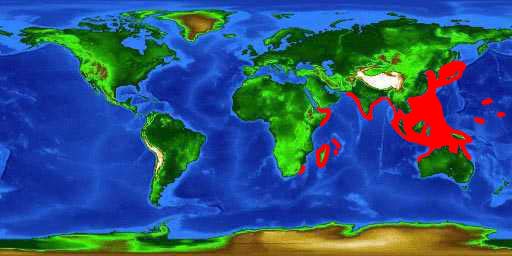
The bluespotted stingray is found in the Indo-West Pacific region including the Red Sea and East Africa to Samoa and Tonga. It is also found north to Japan and south to Australia. In Australian waters, this ray is widespread and common, ranging from north of Port Stephens in New South Wales to Shark Bay off western Australia.
A variety of different color morphs resembling the bluespotted stingray have been recorded in the waters of the Indo-West Pacific. It has yet to be determined if these rays are actually separate species.
Habitat
Occasionally moving onto reef flats and lagoons during high tide, the solitary bluespotted stingray is typically found residing in deeper water (to 295 feet (90 meters)) on sandy bottoms in close proximity to rocky habitats and coral reefs. The bluespotted stingray has been observed covering itself with sand leaving only the eyes and tail visible.
Biology
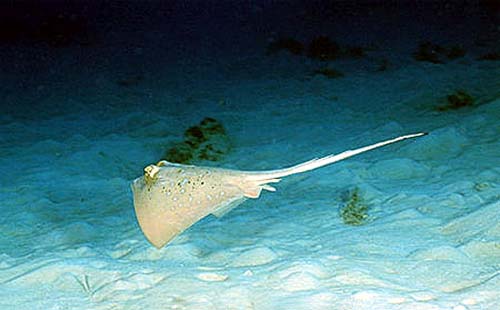
Distinctive Features
The bluespotted stingray is a small to medium-sized stingray in the family Dasyatidae. This disc of the bluespotted stingray is angular with a short angular snout. The eyes are large and the mouth is small. The broad-based tail is as long as the body with a short upper caudal finfold with a longer lower finfold that ends behind the tail tip. There are usually two venomous spines located on the tail.
The bluespotted stingray may be confused with the bluespotted ribbontail ray (Taeniura lymma) which is also found inshore over coral reefs. However, the bluespotted stingray can be distinguished with its more angular disc and a more slender tail.
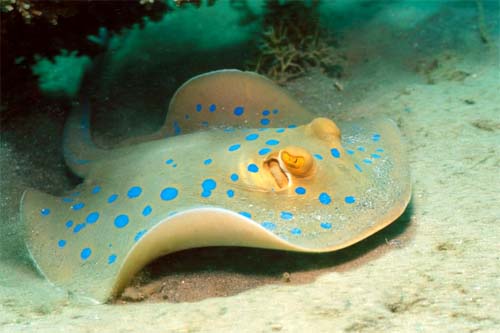
Coloration
The coloration of the bluespotted stingray is reddish-brown to green with bright blue centered spots along with black spots on the dorsal surface. The ventral surface of this ray is white in color. It has a dark brown transverse bar through the eye region. The tail has conspicuous black and white rings with a pale tip.
Dentition
The jaws contain numerous small teeth.The lower jaw is slightly convex. There are two broad papillae located on the floor of the mouth.
Denticles
The skin of the bluespotted stingray lacks thorns with the exception of short thorns confined to a single row along the midline of the disc. These short thorns are lanceolate and flat-topped and extend from the nuchal region almost to over the cloaca in adults. Juveniles often lack thorns.
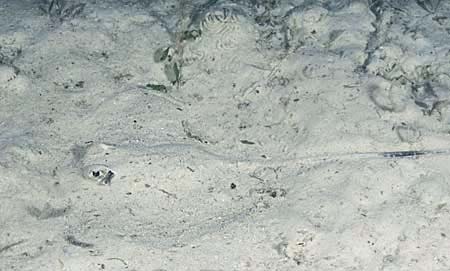
Size, Age, and Growth
The maximum reported size of the bluespotted stingray is 27.6 inches (70.0 cm) total length. It reaches a disc length of at least 29.5 inches (75 cm). Males mature at a disc width of approximately 9.8 inches (25 cm).
Food Habits
The bluespotted stingray feeds primarily on crabs and shrimps. It is also reported to feed on small fishes.
Reproduction
The mode of reproduction of the bluespotted stingray is ovoviviparous. The eggs are retained in the body of the female where the embryos develop while receiving nourishment from yolk sacs. The embryos receive additional nourishment via the absorption of uterine fluid containing fat and protein. Birth is given to 1-2 pups after an unknown gestation period. The young measure approximately 6.3 inches (16 cm) disc width and 13 inches (33 cm) total length at birth.
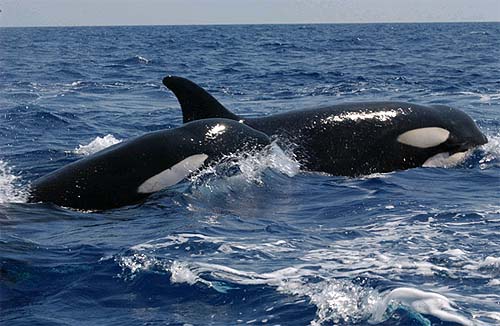
Predators
Killer whales (Orcinus orca) are known predators of the bluespotted stingray. Other potential predators include other marine mammals and large fish such as sharks.
Parasites
Dendromonocotyle kuhlii, a monogean, has been documented as an ectoparasite on the skin of the bluespotted stingray. The cestode Acanthobothrium bengalense has also been reported as a parasite of the bluespotted stingray.
Taxonomy
This stingray was originally named Trygon kuhlii by Müller & Henle in 1841. This name was later changed to the currently valid scientific name Dasyatis kuhlii (Müller & Henle 1841). The genus Dasyatis of the currently accepted scientific name is derived from the Greek word “dasys” meaning rough or dense and (“b)atus” meaning shark. Synonyms appearing in past scientific literature include Raya trigonoides (Castelnau, 1873).
Prepared by: Cathleen Bester